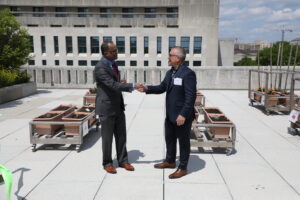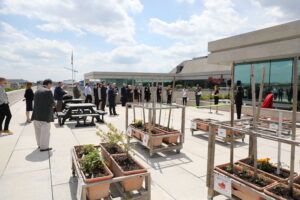Gardens are a great opportunity to bring communities together both locally and internationally. The U.S. Department of Agriculture (USDA) People’s Garden aims to connect people living in the United States to those living all around the world who are collaborating on gardening projects in their own communities. People’s Gardens can take many different forms, including food-producing gardens, wildlife habitats, conservation projects, beautification projects for community spaces, and education and training spaces.
So far, over 1,200 gardens have signed up to be designated as People’s Gardens, now including the community rooftop garden – named the Maple Leaf Gardens – at the Embassy of Canada in Washington, D.C. The Embassy has had its rooftop garden for over 12 years, with the latest addition of two beehives, and is pleased to partner with the USDA on this initiative to further grow and connect with the local community. The Embassy of Canada is the first foreign embassy in Washington, D.C. to join this USDA initiative. Its rooftop garden and beehives help the Embassy reconnect with nature, increase ecological awareness, and encourage us to think about the benefits of sustainable, local agriculture and how gardening can provide green gathering spaces and help the environment.
Like the flagship People’s Garden at USDA headquarters, the Embassy’s garden donates the produce it grows to local communities. The Embassy has partnered with Food Rescue US-DC, a non-governmental organization that is dedicated to eliminating hunger and food waste, that will collect the garden produce and donate it to those in in need. Additionally, in the spirit of Truth and Reconciliation, the Embassy will incorporate Indigenous agricultural practices like growing corn, beans and squash, known as the “Three Sisters”, where crops are planted together for mutual benefit. While this practice is often cited as a way to improve small gardens for individual use, its historical value shows it was designed to nurture and sustain entire communities.
The USDA People’s Gardens can be located at schools, faith-based centers, government property, and other places within the community. They cannot be located at private residences. We encourage community gardens to:
- Join the People’s Garden community.
- Grow using sustainable practices that benefit people and wildlife.
- Teach about local, resilient food systems.
People’s Gardens are listed on an interactive map on the USDA website. After registering, they receive a “People’s Garden” sign to display and are invited to connect with other members of the community and participate in People’s Garden webinars.



